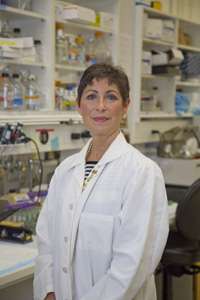Scientists discover new step in a molecular pathway responsible for birth defects

Mary R. Loeken, Ph.D., Investigator in the Section on Islet Cell and Regenerative Biology at Joslin Diabetes Center and Associate Professor of Medicine at Harvard Medical School, has discovered a molecular pathway responsible for neural tube defects in diabetic pregnancies. Her latest research findings in this pathway were published in the October issue of Diabetes.
For 20 years, scientists have known of a gene involved in neural tube defects (such as spina bifida), but until now it was not known exactly what causes this gene to malfunctions during diabetic pregnancies.
A neural tube is the body's first step in assembling the spinal cord and the brain, which takes place within the first two to four weeks of gestation. Since the early 1990's, scientists have known that the gene Pax3 is required for closure of the neural tube.
Diabetic women who become pregnant run a greater than average risk that their baby, while the tube is folding shut, will develop anencephaly, a fatal disorder, or spina bifida, which can lead to motor impairment and other disabilities. For over two decades Dr. Loeken has focused her research on discovering how and why the malfunction of Pax3 can occur in diabetic women when they are pregnant.
In previous research, she found that Pax3 is sensitive to high levels of glucose. When exposed to hyperglycemic events, Pax3 doesn't turn on as much as it is supposed to. This is particularly dangerous as it occurs during the first month of pregnancy when a woman with diabetes may not be aware that she is pregnant and therefore may not take measures to have good control of her blood glucose.
In her paper this month in Diabetes, Dr. Loeken describes what prevents Pax3 from switching on. The key is an enzyme called DNA Methyltransferase (Dnmt), specifically subtype Dnmt 3b. DNA Methyltransferases are a family of enzymes responsible for altering the chemical building blocks of DNA, specifically adding a methyl group to cytosine (one of the four main bases in DNA's "rungs").
In normal development, Dnmt adds methyl groups to DNA around the Pax3 gene and then abruptly tapers off before the Pax3 gene comes on. Dr. Loeken discovered that glucose over-stimulates the DNA Methyltransferase 3b. The overactive enzyme keeps adding methyl groups to the cytosines near the Pax3 gene and prevents Pax3 from turning on so that it can close the neural tube.
Although it would appear that the way to prevent neural tube defects would be to stop Dnmt3b, Dr. Loeken cautions against such radical treatment. "There are actually drugs that can be used to inhibit DNA methylation; however we wouldn't use a drug to interfere with this pathway because this is a tightly regulated process."
According to Dr. Loeken, Dnmt3b isn't an entirely bad enzyme; there are many genes critical for development that need to be switched on or off by DNA methyltransferases. Dnmt3b is essential for embryonic survival. "However," says Dr. Loeken, "It does allow us to elucidate a biochemical pathway that we really didn't understand very well before."
A treatment that may come out of this research is better stem cell therapy. "We might be able to exploit these pathways to make more competent stem cells to repair the congenital malformations," says Dr. Loeken. "And that's not just limited to diabetes."
Neural tube defects happen in non-diabetic pregnancies as well, affecting about 1,500 births in the US every year and around 300,000 worldwide. Dr. Loeken's research has already caught the attention of other scientists working on neural tube defects. Together, they may illuminate causes and treatments for all babies who develop these malformations.
Until a treatment is developed, the best method for safeguarding against complications in diabetic pregnancies, Dr. Loeken points out, is to rigidly control a pregnant woman's blood glucose levels beginning before she is pregnant, and to plan their pregnancies.
"If the mother is under very tight glycemic control and avoids excursions above the level that will drive glucose into the cells, then all the events downstream, including the hypermethylation, should not occur."
More information: Wei, D & Loeken, M. Increased DNA methyltransferase 3b (dnmt3b)-mediated CpG island methylation stimulated by oxidative stress inhibits expression of a gene required for neural tube and neural crest development in diabetic pregnancy. Diabetes; vol 63, pp. 3512-22, October 2014


















